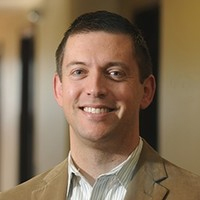Dr. Aaron Levine On FDA's Statement About Dubious Stem Cell Clinics

By Erin Harris, Editor-In-Chief, Cell & Gene
Follow Me On Twitter @ErinHarris_1

Last month, the FDA released a statement by former FDA Commissioner Scott Gottlieb, M.D., and Biologics Center Director Peter Marks, M.D., Ph.D. on FDA’s continued efforts to stop stem cell clinics and manufacturers from marketing unapproved products that put patients at risk. I caught up with Dr. Aaron Levine, Associate Professor, School of Public Policy, Georgia Institute of Technology to get his take on the statement and how dubious players affect the good of the cell and gene sector
Harris: Tell us your thoughts on the FDA’s recent statement. What does this mean for the cell and gene therapy sector?
 Levine: Addressing the dubious side of the cell therapy industry has been an ongoing challenge.
Levine: Addressing the dubious side of the cell therapy industry has been an ongoing challenge.
Former Commissioner Gottlieb deserves credit for prioritizing the challenge of unproven cell therapies and the direct-to-consumer marketing of cell therapies without appropriate safety and efficacy.
During his time as Commissioner, he really did ramp up both enforcement and attention to this issue in a way that was both productive and valuable. I see the FDA’s statement as a part of that ongoing effort.
In some ways, the statement is an acknowledgement that the earlier efforts were not quite as successful as the FDA may have hoped. In recent past, the FDA published revised guidelines that were intended to clarify the requirements and the ways in which their regulatory system applied to this ecosystem of hundreds — if not more than a thousand — of these cell therapy providers around the country that were without appropriate marketing authorization from FDA to make it clear in most cases that the vast majority of these clinics required pre-market approval from FDA.
The guidelines laid out several examples that illustrated why and how these clinics should be moving these products through pre-market approval and clinical trial pathways. As part of that, the FDA granted a grace period to become compliant. In reading between the lines of this statement, most of the clinics ignored this.
Many of the more dubious players already knew that they were in a gray area and have been working with this grace period to continue their business model to continue “treating,” but to continue selling cell-based products without appropriate evidence to patients to continue profiting from that figuring they could wait out the grace period without much consequence.
This latest round of warning letters, in most cases, seem like an acknowledgment that FDA needed to apply more pressure. Of course, it comes at a challenging time for FDA with the transition from Gottlieb to the new acting Commissioner Dr. Ned Sharpless.
The other issue here is it may be that warning letters aren't enough. The model that FDA has had for a long time has been one where they can make an example of bad players or poor players, and the rest of the industry will fall in line.
That works in the mainstream industry where compliance with FDA approval is critical. Unfortunately, I suspect FDA is realizing that these clinics that are either operating in ignorance or defiance of the FDA are not concerned if someone in the industry receives a warning letter. It may not inspire the broader community to shape up.
The FDA needs to send warning letters to everybody and start enforcing much more aggressively, which I believe is unrealistic with their current enforcement budgets and in their capacity. Or, they need to adopt some other strategies.
Harris: How should the industry respond?
Levine: There have been several approaches. There has been almost a decade of attention paid to the development in marketing of unproven cell therapies and attempts to rein in the worst practices to minimize risk to patients and to minimize risks to the field.
I believe that some of this is motivated by concern that the potential of stem cell research, the potential of cell therapies, will be hindered by the growth of this questionable industry. The FDA’s efforts have not been unsuccessful but have been less successful than I think people would have hoped.
There have been many efforts made in patient education. The International Society for Stem Cell Research and the International Society for Cell Therapy, for example, have done a great amount of good, but those efforts only move the needle so far. There have been some efforts through state medical boards and these boards do have some power here if they wanted to handle enforcement, but that’s been relatively limited.
There was an effort through the state attorney general in New York, and so state-level action could prove to be a real positive. Former patients have filed lawsuits against some of these clinics, and that action potentially has a deterrent effect, particularly if it can become a class action type activity where more of these providers or at least big groups of these providers are at some degree of risk.
But all these things have proven to be very difficult to bring to fruition. I do think that the federal regulatory body — whether it’s the FDA or some of the FCC — talking about the marketing claims, in some ways, they have the greatest ability and power to do that, but they also have struggled with having a myriad of set of responsibilities and limited funding.
Then what is the best solution? Is it all-of-the-above? Education? Working with the physicians, working with the physician groups, and the licensing boards at an increased level and intensity? Does that do it or not? I worry it does not. The nature of this industry and the nature of healthcare today is that, unfortunately, we have patients with unmet medical needs. Yet we have great potential — and some hype as well — but, a great deal of potential in the world of cell and gene therapy.
Harris: Where should patients turn to skeptically validate whether their practitioner is providing a sound, compliant therapy?
Levine: This is a real challenge. We can't expect every patient to be an expert in the scientific literature, as that’s simply not feasible. But we would like to provide resources for patients to determine if the clinic they're interested in is legitimate. This is a hard challenge not just for patients but also a challenge for physicians.
Physicians who don’t happen to be a specialist in a specific disease typically don’t have the bandwidth to stay abreast of everything that's going on in condition X or condition Y. The ISSCR has probably done the best job of articulating the set of questions around this topic, as they’ve created a patient handbook with a viable question set to ask the clinic.
The clinics that claim one size, one stem cell, or one cell treats everything should be considered red flags. As of now, stem cell treatments are not going to treat autoimmune disease, baldness, and cancer. That’s just not how medical science works. And enough of these clinics are offering this huge array of treatments; the idea that these stem cells are so powerful that they can fix whatever ails you — from COPD to aging. That is a red flag.
Another challenge is that these clinics are quite sophisticated and take advantage of the term that Douglas Sipp coined, the tokens of scientific legitimacy.
In its statement, FDA suggested clinics should ask to see the IND notification from FDA to verify that these clinics were going through the appropriate pathways. I had not previously heard suggestion, and I’m unsure whether it would work, but it is a signal that FDA is thinking about the verification process and how their materials could be used in this. It was a sign that FDA is aware of this challenge, and I do believe there have been several improvements.
